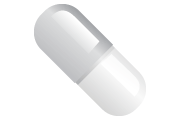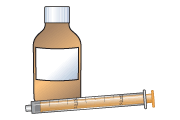Rifampicin for meningococcal prophylaxis
This leaflet is for parents and carers about how to use this medicine in children. Our information may differ from that provided by the manufacturers, because their information usually relates to adults. Read this leaflet carefully. Keep it somewhere safe so that you can read it again.
Rifampicin does not protect your child completely from meningococcal infection. If they have a high temperature or seem unwell, take them to a doctor or hospital straight away.
Name of medicine
Rifampicin
Brand names: Rifadin, Rimactane
Why is it important for my child to take Rifampicin?
Meningococcal bacteria can cause serious, potentially lifethreatening, infections such as meningitis (inflammation of the membrane that surrounds the brain) or septicaemia (blood infection).
Rifampicin kills meningococcal bacteria. If your child has been in contact with someone who is thought to have a meningococcal infection, your doctor may recommend that your child takes rifampicin to reduce the risk of them also developing an infection.
What is Rifampicin available as?
- Capsules: 150 mg, 300 mg
- Liquid medicine: 100 mg per 5 mL (red); this syrup contains sucrose
When should I give Rifampicin
- When used to prevent meningococcal infection, rifampicin is given for 2 days only.
- Give it twice each day, once in the morning and once in the evening. Ideally, these times are 10–12 hours apart, for example some time between 7am and 8 am, and between 7pm and 8 pm.
- You need to give rifampicin to your child when their stomach is empty. Give it about 30 minutes before a meal or 2 hours after a meal.
How much should I give?
Your doctor will work out the amount of Rifampicin (the dose) that is right for your child. The dose will be shown on the medicine label.
It is important that you follow your doctor’s instructions about how much to give.
How should I give Rifampicin?

Capsules
- Capsules should be swallowed with a glass of water or juice, but not milk. Your child should not chew the capsule.

Liquid medicine
- Shake the medicine well.
- Measure out the right amount using an oral syringe or a medicine spoon. You can get these from your pharmacist. Do not use a kitchen teaspoon as it will not give the right amount.
When should the medicine start working?
The medicine will start to work soon after it is given, although you will not see any difference in your child. It is important that your child has the whole course of rifampicin prescribed by your doctor (four doses altogether over 2 days), to make sure that they are protected from infection.
What if my child is sick (vomits)?
- If your child is sick less than 30 minutes after having a dose of Rifampicin, give them the same dose again.
- If your child is sick more than 30 minutes after having a dose of Rifampicin, do not give them another dose. Wait until the next normal dose.
If your child is sick again, seek advice from your family doctor, nurse, pharmacist, or hospital. They will decide what to do based on your child’s condition and the specific medicine involved.
What if I forget to give it?
If you remember up to 4 hours after you should have given a dose, give your child the missed dose. For example, if you usually give a dose at about 7am, you can give the missed dose at any time up to 11am. If you remember after that time, give the dose as soon as you remember. Then give a dose every 12 hours from this new time, until all four doses have been given (this may mean continuing for more than 2 days).
Never give a double dose of Rifampicin.
What if I give too much?
If you think you may have given your child too much Rifampicin, contact your doctor or local NHS services (details at end of leaflet). Have the medicine or packaging with you if you telephone for advice.
Are there any possible side effects?
We use medicines to make our children better, but sometimes they have other effects that we don’t want (side-effects). A short course of rifampicin usually causes only mild side effects, which will disappear when the course is completed.
Side effects you must do something about
If your child is short of breath or is wheezing, or their face, lips or tongue start to swell, or they develop a rash, they may be allergic to Rifampicin. Take your child to hospital or phone for an ambulance straight away.
If your child develops any of the following, take them to your doctor or hospital straight away:
- severe dizziness or faints
- swollen face, stomach, arms or legs, which may mean they have water build up (fluid retention)
- yellowing of skin and/or whites of the eyes
- sores or blisters on the skin or in the mouth
- passing only small amounts of urine (wee) or none at all
- bleeding from the nose, gums or throat, or blood in the urine (wee).
Other side-effects you need to know about
- Your child may feel or be sick, have diarrhoea, get headaches and may feel drowsy (sleepy). These effects should wear off, and will stop when your child has finished the course of rifampicin. If they continue or get worse, contact your doctor.
Rifampicin may make your child’s urine (wee), faeces (poo), saliva (spit), mucus (phlegm), sweat or tears turn an orange-red colour. This is not harmful and will go when your child stops taking this medicine. The red colour in tears may last for some time after your child has stopped taking Rifampicin, and may stain clothes.
There may sometimes be other side effects that are not listed above. If you notice anything unusual and are concerned, contact your doctor. You can report any suspected side effects to a UK safety scheme at mhra.gov.uk/yellowcard
Can other medicines be given at the same time as Rifampicin?
- You can give your child medicines that contain paracetamol or ibuprofen, unless your doctor has told you not to.
- Rifampicin should not be taken with some medicines. Tell your doctor or pharmacist about any other medicines your child is taking before giving Rifampicin.
Check with your doctor or pharmacist before giving any other medicines to your child. This includes herbal and complementary medicines.
The oral contraceptive pill does not work properly during treatment with Rifampicin so your daughter should use other forms of contraception if she is sexually active.
Is there anything else I need to know about this medicine?
Rifampicin reduces the risk of your child getting meningitis or septicaemia, but does not provide complete protection.
If your child has a high temperature (above 38°C) or they seem unwell, take them to the doctor or hospital straight away.
Your child should not wear soft contact lenses, as they may become stained by Rifampicin.
- It is important that your child takes the whole course of rifampicin (usually four doses over 2 days), to make sure that they are protected from infection.
- Rifampicin is also used in the treatment and prevention of tuberculosis (TB) but is given for a much longer time. Side-effects are more likely when it is used for TB.
- Rifampicin is an antibiotic.
General advice about medicines
- Only give this medicine to your child. Never give it to anyone else, even if their condition appears to be the same, as this could do harm.
If you think someone else may have taken the medicine by accident, contact your doctor straight away.
Where should I keep this medicine?
- Keep the medicine in a cupboard, away from heat and direct sunlight.
- It does not need to be kept in the fridge.
- Make sure that children cannot see or reach the medicine.
- Keep the medicine in the container it came in.
- It is important to keep Rifampicin somewhere where it cannot get damp.
Who to contact for more information?
Your child’s doctor, pharmacist or nurse will be able to give you more information about Rifampicin and about other medicines used to treat infections.
England: NHS 111
Tel 111
www.nhs.ukScotland: NHS 24
Tel 111
www.nhs24.scotNorthern Ireland: NI Direct
Wales: NHS 111 Wales
Tel 111
www.111.wales.nhs.ukMeningitis Now
0808 80 10 388
www.meningitisnow.org/Copyright disclaimer
Version [2]. © NPPG, RCPCH and WellChild, all rights reserved. Review by March 2022.
The primary source for the information in this leaflet is the British National Formulary for Children. For details on any other sources used for this leaflet, please contact us through our website, www.medicinesforchildren.org.uk.
We take great care to make sure that the information in this leaflet is correct and up-to-date. However, medicines can be used in different ways for different patients. It is important that you ask the advice of your doctor or pharmacist if you are not sure about something. This leaflet is about the use of these medicines in the UK, and may not apply to other countries. The Royal College of Paediatrics and Child Health (RCPCH), the Neonatal and Paediatric Pharmacists Group (NPPG), WellChild and the contributors and editors cannot be held responsible for the accuracy of information, omissions of information, or any actions that may be taken as a consequence of reading this leaflet.
